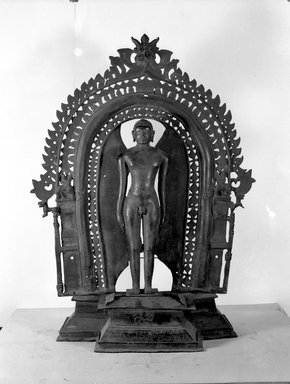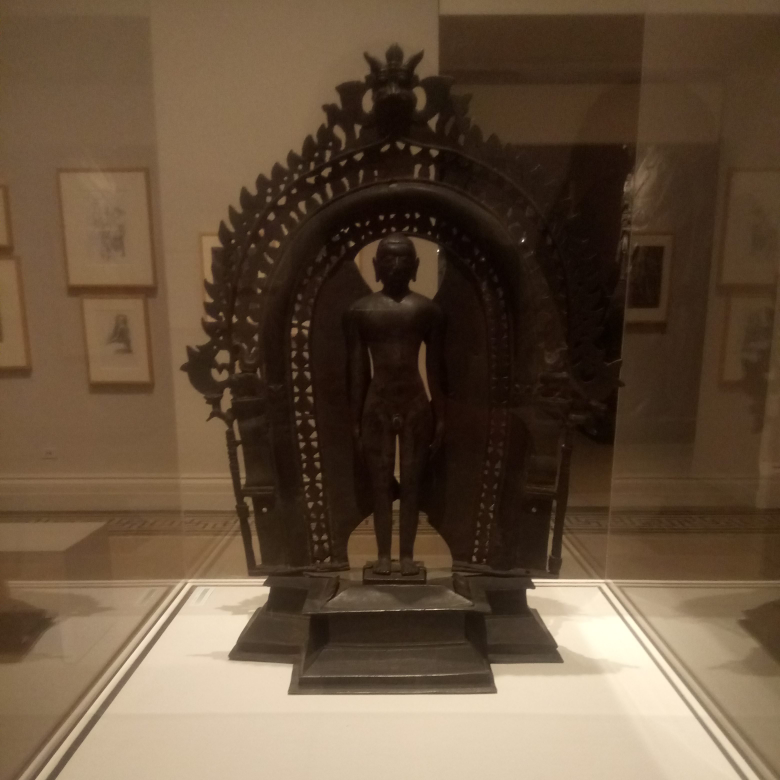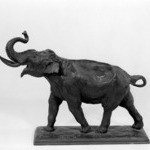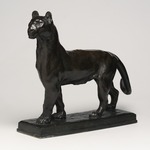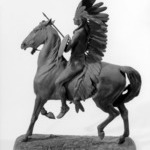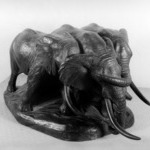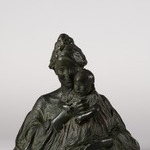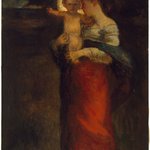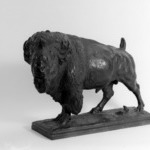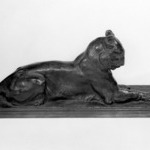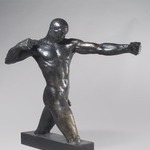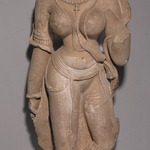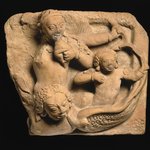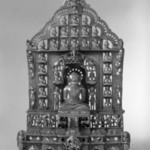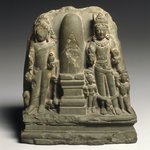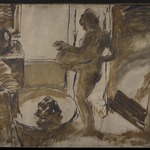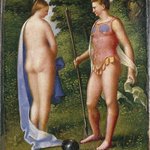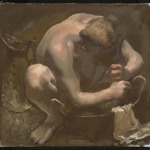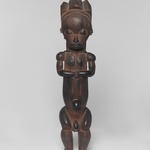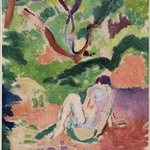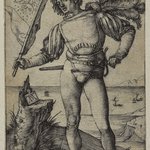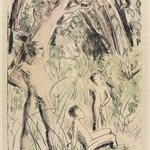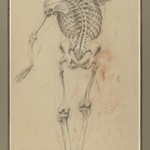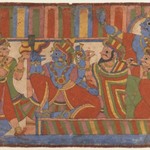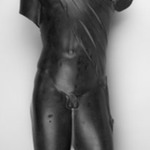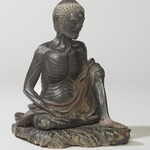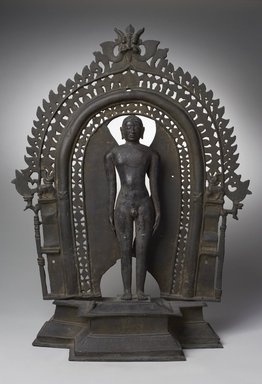

Jina Mahavira, 11th-12th century (image); 16th century (base and halo). Bronze, 24 1/2 × 18 1/2 × 7 7/8 in. (62.2 × 47 × 20 cm). Brooklyn Museum, Robert B. Woodward Memorial Fund, 34.752a-b. Creative Commons-BY (Photo: Brooklyn Museum, 34.752_front_PS11.jpg)
Jina Mahavira
Asian Art
On View: Asian Galleries, Arts of South Asia, 2nd floor
This sculpture depicts the Jina Mahavira, the founder of the Jain religion and a historical contemporary of the Buddha. Here, Mahavira is shown as a Digambara, or “person clothed by air.” The Digambara sect of Jainism practices nudity as a form of asceticism. His nudity reflects his commitment to the most extreme and highest level of Jain practice. Additionally, the Jina is depicted engaged in standing meditation. This form of meditation is performed motionless and upright with hands at the sides as a method of gaining control of the body and thoughts. Ultimately, this work is centered on the idea of denying the power of the body and, despite its use of nudity, has no sexual connotations. It is actually an act of religious devotion.
MEDIUM
Bronze
DATES
11th-12th century (image); 16th century (base and halo)
DIMENSIONS
24 1/2 × 18 1/2 × 7 7/8 in. (62.2 × 47 × 20 cm) (show scale)



COLLECTIONS
Asian Art
ACCESSION NUMBER
34.752a-b
CREDIT LINE
Robert B. Woodward Memorial Fund
PROVENANCE
Prior to 1920, provenance not yet documented; by March 1920, acquired by William O. Oldman, London; March 1920, purchased from William O. Oldman by Stewart Culin for the Brooklyn Museum.
Provenance FAQ
CATALOGUE DESCRIPTION
Bronze image (murti) of the twenty-fourth Jina, Mahavira, standing on a low square pedestal. The figure and pedestal rest on a rectangular base (bhadrapitha), which supports a large, arched screen (torana) behind. The figure is completely nude, indicating that the ascetic is of the Digambara sect. He stands in the characteristic Jaina pose with the body erect (samabhanga) and arms pendant, but with the hands not touching the thighs. The hair is spirally curled and the earlobes pendant. The torana (markara torana) is a high arched screen back. The lower part is of the simple architectural throne back type with supporting columns on each side, terminating in figures of lions in full relief. The arch rests on 2 small figures: reliefs of elephants with markara heads. The arch itself is comprised of an incised double row of projecting flame tongues (jvala) and is surmounted by a large grotesque head called a kirtimukha. The niche within the arch directly behind the figure is plain, with an incised border of diamond-shaped motifs. The front of the base upon which the figure stands bears an incised figure of a lion, the cognizance (cihna, identifying emblem) of Mahavira. On the lower projection of the base there is an inscription in Kanada script in three rows. The brass has darkened.
Sculpture comprised of two parts: figure and base
EXHIBITIONS
MUSEUM LOCATION
This item is on view in Asian Galleries, Arts of South Asia, 2nd floor
CAPTION
Jina Mahavira, 11th-12th century (image); 16th century (base and halo). Bronze, 24 1/2 × 18 1/2 × 7 7/8 in. (62.2 × 47 × 20 cm). Brooklyn Museum, Robert B. Woodward Memorial Fund, 34.752a-b. Creative Commons-BY (Photo: Brooklyn Museum, 34.752_front_PS11.jpg)
IMAGE
front, 34.752_front_PS11.jpg. Brooklyn Museum photograph, 2016
"CUR" at the beginning of an image file name means that the image was created by a curatorial staff member. These study images may be digital point-and-shoot photographs, when we don\'t yet have high-quality studio photography, or they may be scans of older negatives, slides, or photographic prints, providing historical documentation of the object.
RIGHTS STATEMENT
Creative Commons-BY
You may download and use Brooklyn Museum images of this three-dimensional work in accordance with a Creative Commons license. Fair use, as understood under the United States Copyright Act, may also apply.
Please include caption information from this page and credit the Brooklyn Museum. If you need a high resolution file, please fill out our online application form (charges apply).
For further information about copyright, we recommend resources at the United States Library of Congress, Cornell University, Copyright and Cultural Institutions: Guidelines for U.S. Libraries, Archives, and Museums, and Copyright Watch.
For more information about the Museum's rights project, including how rights types are assigned, please see our blog posts on copyright.
If you have any information regarding this work and rights to it, please contact copyright@brooklynmuseum.org.
RECORD COMPLETENESS
Not every record you will find here is complete. More information is available for some works than for others, and some entries have been updated more recently. Records are frequently reviewed and revised, and we welcome any additional information you might have.
